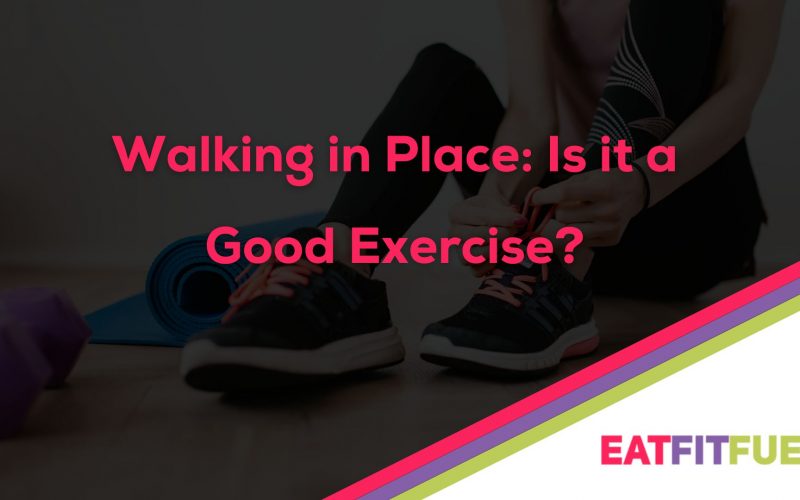Anything that gets you moving instead of sitting or lying down is beneficial to your health. Thus, it’s important you find those moments where you get a few minutes of exercising to improve your lifestyle.
Note that walking in place is not only a preserve for those on their fitness journey. It has a lot of benefits that make it valuable for everyone and can be done anywhere. Think about walking in place in the kitchen while making dinner, watching television, or just standing around somewhere, like at the store. Keep reading as we explore its benefits and why you should integrate it into your routine.
Overview
The Benefits of Walking in Place
- Improved Health
- Maintaining Healthy Weight
- Improves your Mood
- Improved Sleep
How to Get Started With Walking in Place
Using Walking in Place for Weight Loss
The Mental Health Benefits of Walking in Place
Reviews and Test Results on the Effectiveness of Walking
Expert Opinions on Incorporating Walking
Conclusion
Frequently Asked Questions
The Benefits of Walking in Place
Walking in place, also known as “Marching on the spot,” might seem too simple to offer much in terms of fitness. However, it is a form of physical activity that can significantly improve cardiovascular health and leg strength.
Moreover, there are people who, despite having every intention to engage in physical activities, their work schedule or life won’t let them. That may be because it’s unsafe to walk on the busy streets where they live, or they have health issues that make it difficult to go to the gym. Or maybe they can’t afford to spare 30 minutes of a workout in their busy schedule between work, chores, and spending time with family and friends.
Walking in place is a simple and convenient option that can help anyone stay active, and you don’t even need to have any equipment or go anywhere special. You only need a good pair of shoes, and you’re on your way to staying strong and healthy. Below are the benefits that come with it:
- Improved Health
Walking in place is important when it comes to boosting your cardiovascular health. That’s because it helps to strengthen your heart, lungs, and muscles, hence prolonging your life.
When it comes to strengthening your heart, the best part about this activity is that it doesn’t exert a lot of pressure on the heart. It is unlike running or playing sports that place extreme stress on the heart.
It’s also easier to keep up with walking in place when you get older or have health issues that can make it difficult to run. You can do it anytime, including while waiting for someone to answer the phone.
This form of exercise also leads to adaptations such as lowered resting heart rate and blood pressure. That’s because it boosts blood flow and circulation, hence providing more oxygen to working muscles. This helps reduce the chances of heart disease as well as stroke.
- Maintaining Healthy Weight
Walking in place helps to maintain a healthy weight or even lose weight. This physical activity can be done at a moderate pace or slowly based on what’s more comfortable for you. Also, while walking in place, you use your arms to keep balance and stability. The end result is that you build muscle tone and even lose weight.
This exercise can be done at least three times a week for 30 minutes every time to get the benefits. This is similar to walking a mile three times a week, so yes, it counts as an exercise.
So, if you’re hoping to achieve and maintain a healthy weight, consider visiting a professional who will assess you and help you determine the weight you should strive towards. They will also help you know how many calories you should consume daily to reach your goal.
- Improves your Mood
A glass of wine or a piece of dark chocolate can blunt the edge of a rough day. But walking in place is a zero-calorie strategy that provides the same perk. According to the National Library of Medicine, 10 minutes of walking helps to lift your spirits. Just like during the peak of COVID-19, it was proved that walking could significantly improve one’s mood.
The results are even better when you take nature walks. This kind of walk helps to inspire positive feelings, including joy and calmness. Feeling connected to nature helps you to feel less anxious or depressed. Research also suggests that nature decreases mental distress and increases your sense of purpose and meaning. This serves to create a more positive outlook on life.
- Improved Sleep
Walking in place regularly helps an individual to sleep better at night as physical activity naturally boosts the effects of melatonin. Research suggests that postmenopausal women who do light to moderate-intensity physical activity sleep better at night.
Moreover, healthy adults who walk daily are able to have quality sleep. It also helps to reduce pain and sleep that may cause sleep disturbances.
How to Get Started With Walking in Place
Would you like to experience the benefits of walking in place? Here are some of the tips that will help you get started:
Put on a good pair of walking shoes: Walking without shoes is okay, only if done for a few minutes. But if you plan to walk for much longer, it would be best to put on walking shoes as it ensures that your feet have the much-needed support.
Stretching: This is one of the safest ways of reducing soreness or injury. It also helps to speed up recovery time. So ensure that you stretch out any areas that may feel tight, such as the ankles, feet, hamstring, wrists, and back.
Warm-up: Warming up is just as important as stretching. It helps to increase the effectiveness of your workout session. Warm up by walking around in place for at least five minutes before gradually increasing the intensity of your session.
Start walking: This step is just as simple as it sounds. So the next time you find yourself sitting, get up and begin walking in place for the sake of your health.
Start small: Start with two minutes of walking daily and increase the duration with time as your body adapts. This is helpful because the gradual build-up will help to prevent overexertion.
Track your step: Motivation is key regardless of whether you go with a Fitbit or an inexpensive pedometer. You can also choose to use a health application on your smartphone to see how many steps you can rack up. This will help to motivate you while walking in place.
Use a heart rate monitor: You might wonder whether walking in place will raise your heart rate enough to improve your cardiovascular health. In that case, wearing a heart rate monitor will help ensure you’re in your target heart rate zone. You can also lift your knees or swing your arms higher to kick it up a notch.
Do intervals: If you find the idea of walking in the same place monotonous, consider picking up the speed for a minute or two and dropping it back down. Keep alternating between faster and slower paces for an interval training workout.
Focus on posture: Stand tall with a slight forward lean to engage core muscles and keep the head level.
Using Walking in Place for Weight Loss
Apart from its other benefits, walking in place can be a simple and sustainable option if you want to lose weight. Here’s how it contributes to weight loss:
Calorie burn: At a moderate, brisk pace, walking in place burns about 6-10 calories per minute. This, of course, depends on your body weight. This can quickly add up through consistent practice, so be patient.
It suppresses appetite: According to studies, even short 15-minute walking sessions help to effectively reduce cravings. It also reduces the desire to snack in overweight adults.
Increased metabolism: Frequent walking keeps the metabolism fired up. This leads to increased passive calorie burning 24/7. Integrating walking breaks throughout the day maximizes this effect.
Walking in place alone may not produce dramatic weight loss. However, small, consistent changes compound over time. When combined with a healthy diet, this simple physical exercise will eventually accelerate weight management.
The Mental Health Benefits of Walking in Place
So, you don’t have a gym membership that can help you boost your mental health? How about walking in place, an exercise that everyone can take part in and do regularly? Here are some of the benefits that it brings to your mental health.
Enhanced mood: Walking for at least 30 minutes a day, three to four times a week, helps to improve a person’s mood compared to reading a book.
Reduced stress: Walking helps to relieve stress and improve a person’s appetite, making it easier to sleep well at night.
Improved self-esteem: Walking in place, especially at a park, helps to positively impact a person’s self-esteem. So try and surround yourself with nature to improve your self-esteem.
It stops cognitive decline: Walking in place helps individuals to concentrate better and experience less memory loss. Regular walking also helps to stop the progression of dementia and Alzheimer’s.
Increased blood circulation: The increased blood circulation helps to supply oxygen and nutrients to the brain, hence enhancing cognitive abilities.
Reviews and Test Results on the Effectiveness of Walking
Research and user reviews affirm the diverse benefits of walking, as shown in this article:
- A meta-analysis in the British Journal of Sports Medicine indicates that walking provides clear improvements in resting blood pressure. This is the same case with body composition and cholesterol.
- A study of over 70,000 adults found that walking just 75 minutes per week helps to decrease the risk of being diagnosed with depression by 26%.
- App user Lucy F. reports that she started doing 5-minute treadmill walking breaks at work. The result is that she got a boost in energy and productivity in her work.
The broad evidence proves that walking is an adaptable form of physical exercise that can significantly improve a person’s physical and mental health.
Expert Opinions on Incorporating Walking
Fitness experts like Jarlo Ilano affirm that walking is good for all because of its versatility:
“I’m a huge fan of walking. It comes with a lot of benefits with minimal risk. I recommend walking as a form of active recovery after intense training sessions. It’s good for cardio without the high impact. I would suggest short walks every day to stay active and reduce stress.” – Jarlo Ilano, Physical Therapist & Founder of GMB Fitness.
The unique advantages of walking in place make it something experts continually recommend.
Conclusion
If you intend to improve your health, don’t look at walking in place as a simple and unimportant activity, as it can be a game-changer for your physical and mental health.
Consider walking in place as a good leverage if your health, safety, and busy schedule make it challenging for you to go to the gym. It helps to improve your mental health, among other amazing benefits. Remember to speak with your doctor before starting a new exercise routine to ensure sustainability.
Frequently Asked Questions
Does walking around the house count as exercise?
Any movement you do can help you to become more physically active and improve your health if that’s your goal. So yes, walking in place in your house or any other place counts as exercise.
Does walking in place lead to weight loss?
Yes, it does. Anyone can lose weight by walking in place as it leads to a burn of calories, especially if they were sedentary before. For faster and more impactful results, integrate walking in place with a healthy and well-balanced diet.
How many calories can a person burn walking in place for at least 30 minutes?
Walking in place helps to burn roughly 258 calories per hour. This equates to 129 calories for 30 minutes.




